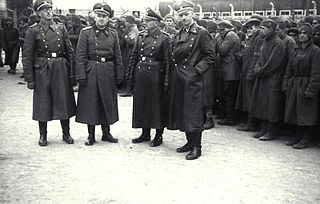 W
WThe 6th Panzer Army was a formation of the German Army, formed in the autumn of 1944. The 6th Panzer Army was first used as an offensive force during the Battle of the Bulge, in which it operated as the northernmost element of the German offensive. The army was subsequently transferred to Hungary in early 1945 and used in both offensive and defensive actions there. The final battles of the 6th Panzer Army were fought in Austria, preventing its fall to Soviet forces. The remnants of the army eventually surrendered to the United States Army. Army commander throughout the army's existence, SS-Oberstgruppenführer Josef Dietrich said in early 1945:"We call ourselves the "6th Panzer Army", because we've only got 6 Panzers left".
 W
WThe 500th SS-Parachute Battalion was the parachute unit of the Waffen-SS. The idea to form a paratrooper unit within the Waffen-SS allegedly came directly from Reichsführer-SS Heinrich Himmler.
 W
WFree Corps Denmark was a Danish volunteer free corps created by the Danish Nazi Party (DNSAP) in cooperation with Nazi Germany, to fight the Soviet Union during the Second World War. On 29 June 1941, days after the German invasion of the Soviet Union, the DNSAP's newspaper Fædrelandet proclaimed the creation of the corps. Its formation was subsequently sanctioned by the democratically elected Danish government which authorised officers of the Danish Army to join the unit. The corps was disbanded in 1943. During the course of the war, approximately 6,000 Danes joined the corps, including 77 officers of the Royal Danish Army.
 W
WThe Latvian Legion was a formation of the German Waffen-SS during World War II. Created in 1943, it consisted primarily of ethnic Latvian personnel. The legion consisted of two divisions of the Waffen-SS: the 15th Waffen Grenadier Division of the SS, and the 19th Waffen Grenadier Division of the SS. The 15th Division was administratively subordinated to the VI SS Corps, but operationally it was in reserve or at the disposal of the XXXXIII Army Corps, 16th Army, Army Group North. The 19th Division held out in the Courland Pocket until May 1945, the close of World War II, when it was among the last of Nazi Germany's forces to surrender.
 W
WNorwegian Legion was a Norwegian collaborationist formation of the Waffen-SS during World War II. It was formed in German-occupied Norway on 29 June 1941, in support of the war aims of Nazi Germany. The unit was disbanded in 1943.
 W
WPanzer Brigade 150 or SS Panzer Brigade 150 was a formation of the German Army during World War II that was formed to take part in the Ardennes offensive. It was unusual in that it was formed from all parts of the German Armed Forces; the 2,500 men in the brigade were formed from 1,000 from the Heer, 500 from the Waffen SS, 800 from the Luftwaffe and 200 from the Kriegsmarine. It was tasked with the capture of the bridges at Amay, Engis and Huy. The Brigade is known for including English-speaking members wearing American Army uniforms to cause disruption and disinformation behind the American lines. The Brigade was also issued captured Allied equipment and had two Sherman tanks and German vehicles were modified to resemble Allied armoured vehicles.
 W
WThe Signal Corps or Nachrichtentruppe des Heeres, in the sense of signal troops, was an arm of service in the army of the German Wehrmacht and Waffen SS, whose role was to establish and operate military communications, especially using telephone and radio networks.
 W
WSS Heimwehr "Danzig" was an SS unit established in the Free City of Danzig before the Second World War. It fought with the German Army against the Polish Army during the invasion of Poland, and some of its members committed a massacre of Polish civilians. After this it became part of the 3rd SS Totenkopf Division and ceased to exist as an independent unit.
 W
WSS-Totenkopfverbände was the SS organization responsible for administering the Nazi concentration camps and extermination camps for Nazi Germany, among similar duties. While the Totenkopf (skull) was the universal cap badge of the SS, the SS-TV also wore the Death's Head insignia on the right collar tab to distinguish itself from other Nazi Schutzstaffel (SS) formations.
 W
WSS-Truppenübungsplatz Böhmen was one of Waffen-SS training area in the territory of Protectorate of Bohemia and Moravia in time of World War II. Originally was called SS-Truppenübungsplatz Beneschau, because it was situated near city of Benešov.